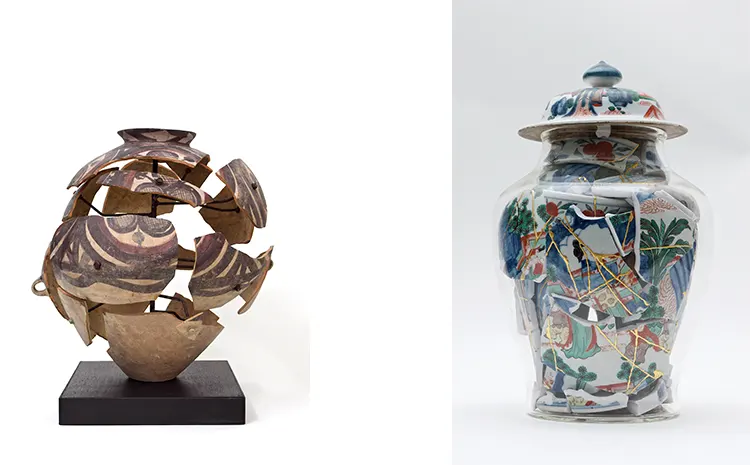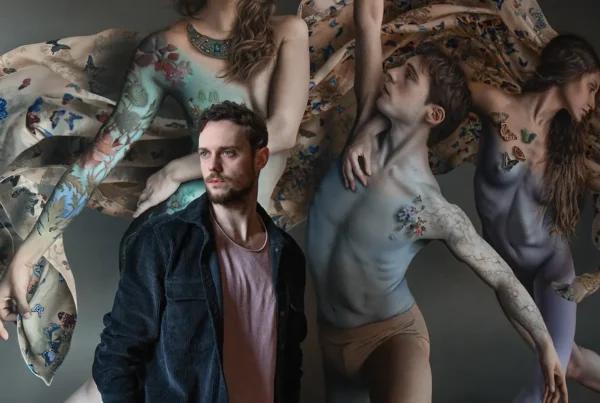“I think my style is pretty much my own, I’m looking at aspects of damage and beauty and the value systems surrounding these.”
The Unconventional Path to Artistry
Bouke de Vries, a Dutch artist residing in London, has traversed an unconventional path in the art world. Originally trained as a textile designer, de Vries’s journey took a pivotal turn towards ceramics, eventually leading him to become a restorer. This unique background laid the foundation for his current vocation as an artist. His Dutch roots and experiences in London have amalgamated, influencing his distinctive artistic style. De Vries’s journey is a testament to the idea that it’s never too late to pursue one’s true calling. His realization that his skills as a restorer could be creatively repurposed marked the beginning of his artistic career. This epiphany underscores a broader theme in his work: the transformation and reinterpretation of what already exists.
De Vries’s artistic style is distinctly his own, characterized by a fascination with the interplay between damage and beauty. He delves into the complex value systems that govern these concepts, often using damaged antique ceramics as his canvas. This choice of medium is not coincidental but deeply symbolic, reflecting his interest in the historical significance of objects. The artist’s approach goes beyond mere restoration; it’s an exploration of how the past can be recontextualized to make compelling statements about the present. His work serves as a bridge between history and contemporary art, inviting viewers to reconsider their perceptions of value and beauty.

Bouke de Vries: Influences and Inspirations
Bouke de Vries draws inspiration from a tapestry of influences, with history playing a central role. Since childhood, he has been captivated by historical narratives, which continue to be a wellspring of inspiration for his artwork. This fascination with the past is not just about nostalgia but about understanding and reinterpreting historical contexts to create something entirely new. De Vries’s work is thus a dialogue between the past and the present, offering fresh perspectives on both.
One piece that holds a special place in de Vries’s heart is a white figurine of a Dutch boy. This piece, which kickstarted his artistic journey, symbolizes the genesis of his unique approach. Damaged during a house move and subsequently repaired by de Vries using his restorative skills, this figurine epitomizes his philosophy of finding beauty in imperfection and the transformative power of art. It’s not just an artwork but a narrative of personal and artistic growth. This piece, along with others, reflects de Vries’s preference for ceramics, though he is not averse to experimenting with other mediums like wood, glass, and plaster. His openness to various materials speaks to his versatile artistic vision and willingness to explore new creative avenues.

Creating Amidst Solitude
For Bouke de Vries, the creative process is deeply intertwined with his environment and work habits. The serenity of his garden studio in London plays a pivotal role in nurturing his artistic endeavors. This personal space, secluded from the hustle of city life, provides de Vries with the tranquility necessary for introspection and creativity. The artist cherishes this solitude, finding in it the perfect setting for his artistic explorations. Accompanied by the ambient sound of a radio, his studio becomes a sanctuary where ideas can germinate and flourish. This setting is integral to his creative process, facilitating a deep focus that allows him to become completely immersed in his work.
Handling distractions is an art in itself, and de Vries has mastered this aspect of the creative process. Once engrossed in his work, external disturbances fade into the background, allowing him to maintain an unwavering focus on his art. This ability to concentrate is not just a testament to his dedication but also a crucial factor in the complex and delicate nature of his work, especially when working with fragile materials like ceramics. The artist’s work environment and his approach to distractions underscore an essential aspect of creativity: the need for a space that aligns with one’s personal rhythm and the discipline to maintain focus amidst the chaos of the outside world.

Bouke de Vries: Dreams and Realizations
Bouke de Vries approaches his artistic aspirations with a unique philosophy: if he dreams of a project, he finds a way to bring it to fruition. This attitude has been a driving force behind his successful career, enabling him to transform creative visions into tangible artworks. De Vries’s belief in the eventual realization of his ideas is not just wishful thinking but a pragmatic approach to handling the uncertainties inherent in the creative process. He views unrealized projects not as failures but as ideas waiting for their right moment. This optimistic and determined mindset allows him to pursue his artistic goals without the burden of disappointment.
This philosophy is evident in de Vries’s diverse body of work. While ceramics remain his primary medium, his willingness to experiment with other materials like wood, glass, and plaster reflects his open-minded approach to art. Each project, whether realized immediately or over time, is an opportunity for exploration and growth. De Vries’s attitude towards his artistic journey is emblematic of a broader principle in the creative world: that the process of making art is as important as the final product. His journey from a restorer to an artist who redefines damaged antiques, his ability to find inspiration in history, and his philosophy of turning dreams into reality all contribute to the unique tapestry of his artistic career. Bouke de Vries’s story is not just about the art he creates but also about the resilience, adaptability, and optimism that define his approach to life and art.






